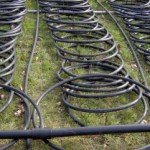On this page, we’ll discuss Deep Retrofits and Geothermal Heating Systems, one of the 5 action areas identified in the Road to Resilience R2Rv2 Study.
Much of the energy used to heat buildings comes from fossil fuels. Simply switching to electric heating would require enormous amounts of electricity. Conducting building retrofits is one of the most cost-effective ways to reduce energy usage in buildings. It is also an essential step towards achieving our R2Rv2 objectives.
Click a link in the list above to jump to that topic on this page.
Retrofits
Building retrofits can be classified as either light or deep. We need widespread deep retrofits in order to meet our R2Rv2 objectives.
-
-
- Light retrofits involve less investment and achieve minimal efficiency gains, such as from upgrading furnaces, replacing windows etc. Data from Natural Resources Canada suggest that 1 million residential retrofits have occurred so far in Canada. Almost all have been “light” retrofits, achieving on average about 23% efficiency improvement. This level of retrofit is not sufficient to achieve the energy reduction targets that Manitoba needs to immediately move away from fossil fuels.
- Deep retrofits require more upfront investment and deliver substantial energy savings. They usually include a complete building enclosure upgrade (walls, roof, basement, windows, doors etc), a switch to geothermal energy, and installation of on-site/rooftop solar panels. Deep retrofits will reduce a building’s total energy consumption by 60%, 80% or even achieve Net Zero Energy status by generating electricity on-site.
-
Geothermal

Geothermal loops (before installation below ground)
Geothermal heating systems (or more accurately ground-source heat pumps) use electricity to extract heat from below the ground surface and use it to heat buildings. This process can be reversed to cool buildings in the summer time.
Although individual systems can be installed for each building, district heating systems that connect multiple buildings together will allow for increased efficiency. These systems could be installed under laneways, roadways, parking lots, athletic fields, and other public property. Installation in areas like this reduces the disruption to individual properties and improves cost efficiency.
Technical Analysis
Details and Assumptions
- We assume that 95% of all buildings in Manitoba undergo deep retrofits by 2050, cutting each building’s total energy use by 65% on average.
- Total annual energy use for all buildings in Manitoba in 2020/21 is 20,100 GWh.





